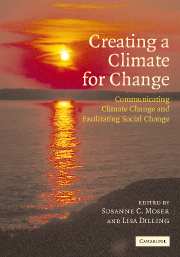Book contents
- Frontmatter
- Contents
- Preface
- Foreword
- List of contributors
- List of tables
- List of figures
- List of text boxes
- Introduction
- Part I Communicating climate change
- 1 Weather or climate change?
- 2 Communicating the risks of global warming: American risk perceptions, affective images, and interpretive communities
- 3 More bad news: the risk of neglecting emotional responses to climate change information
- 4 Public scares: changing the issue culture
- 5 The challenge of trying to make a difference using media messages
- 6 Listening to the audience: San Diego hones its communication strategy by soliciting residents' views
- 7 The climate-justice link: communicating risk with low-income and minority audiences
- 8 Postcards from the (not so) frozen North: talking about climate change in Alaska
- 9 Climate change: a moral issue
- 10 Einstein, Roosevelt, and the atom bomb: lessons learned for scientists communicating climate change
- 11 Across the great divide: supporting scientists as effective messengers in the public sphere
- 12 Dealing with climate change contrarians
- 13 A role for dialogue in communication about climate change
- 14 Information is not enough
- Part II Facilitating social change
- Part III Creating a climate for change
- About the authors
- Index
- References
8 - Postcards from the (not so) frozen North: talking about climate change in Alaska
Published online by Cambridge University Press: 20 August 2009
- Frontmatter
- Contents
- Preface
- Foreword
- List of contributors
- List of tables
- List of figures
- List of text boxes
- Introduction
- Part I Communicating climate change
- 1 Weather or climate change?
- 2 Communicating the risks of global warming: American risk perceptions, affective images, and interpretive communities
- 3 More bad news: the risk of neglecting emotional responses to climate change information
- 4 Public scares: changing the issue culture
- 5 The challenge of trying to make a difference using media messages
- 6 Listening to the audience: San Diego hones its communication strategy by soliciting residents' views
- 7 The climate-justice link: communicating risk with low-income and minority audiences
- 8 Postcards from the (not so) frozen North: talking about climate change in Alaska
- 9 Climate change: a moral issue
- 10 Einstein, Roosevelt, and the atom bomb: lessons learned for scientists communicating climate change
- 11 Across the great divide: supporting scientists as effective messengers in the public sphere
- 12 Dealing with climate change contrarians
- 13 A role for dialogue in communication about climate change
- 14 Information is not enough
- Part II Facilitating social change
- Part III Creating a climate for change
- About the authors
- Index
- References
Summary
In May 2003 and again in January of 2004 a small group of climate change researchers and educators, we among them, met with Alaska Natives in the remote Koyukon Athabascan village of Huslia. We gathered in the log community hall to discuss local and regional impacts of climate change and wildfire. The Huslia Tribal Council hosted the workshop, called in response to concerns heard from Elders from the region about the recent changes seen in the weather, the animals, and the landscape. These were not the expected variations in the climate – something these people had been adapting to as long as they inhabited the region. Rather, these were changes never seen before or told of in their traditional stories passed down for generations. The weather and its spirit, the Elders said, had become different, less predictable.
A long time ago our Elders used to be able to tell the weather, but nowadays they can't even tell weather. My grandfather and my grandfather before that, they said once man starts fooling around with the moon, the weather's going to change. Well, the weather did change …. We're not having the weather we usually have … and it affects the wildlife too … I'm sure a lot of the Elders here have the same question that I'm asking right now – what's happening to our Earth's atmosphere? What's going on out there with this crazy weather? We had a warm winter – no 80 below in the last 3 years, never got more than 40 below. […]
- Type
- Chapter
- Information
- Creating a Climate for ChangeCommunicating Climate Change and Facilitating Social Change, pp. 139 - 152Publisher: Cambridge University PressPrint publication year: 2007
References
- 4
- Cited by

